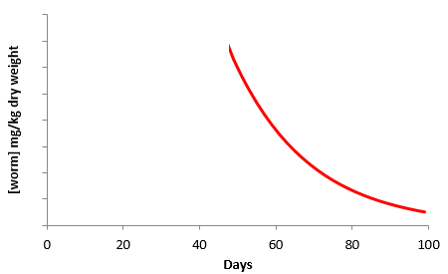Bio-elimination
Bio-elimination of ENMs indicates the process whereby nanomaterials are excreted from an organism’s body. This elimination can occur in different forms, and depends entirely on:
- the type of ENM
- the internal concentrations of the ENMs in the organism
- the physiology of the organism
It is assumed that external concentrations of ENMs do not affect the rate of elimination.
Occurs in |
|
 |
|
Fate descriptors |
Algorithms |
|
Elimination curve when organism has been moved to clean medium (on day 50) (conceptual graph of exposure experiment) Elimination rate constant |
Elimination takes place together with uptake in contaminated media [equation 1]. Elimination also occurs in clean media, whereas no actual uptake takes place there [equation 2]. Elimination of a single form of the ENM is calculated below. 1. Elimination when exposed in contaminated medium \(C_{org}= C_{env} \ast k_{1}\ast SF \ast t + C_{env} \ast \frac{k_{1}}{k_{2}+k_{g}}\ast (1-e^{-(k_{2}+k_{g})\ast t})(1 - SF)\) 2. Elimination when exposed in clean medium after tm days in contaminated medium \(C_{org}= C_{env} \ast k_{1} \ast SF \ast t_{m} + C_{env} \ast \frac{k_{1}}{k_{2}+k_{g}}\ast (1-(e^{-(k_{2}+k_{g})\ast t}\ast e^{-(k_{2}+k_{g})\ast(t-t_{m})})\ast (1-SF)\) Where: \(C_{org}\) - Concentrations in the organism (\(\mu g/g\)) \(k_{g}\) - growth dilution constant (day-1) \(SF\) - stored fraction (\(0\leq SF\leq 1\)) (unitless) \(t\) - total time of experiment (day) \(t_{m}\) - time of transfer from contaminated to clean soil (day)
Visit the Uptake, elimination and growth dilution page. |
Read more |
Read also |
|
Visit the NanoFASE Library to read summaries of these reports: NanoFASE Report D9.2 Loureiro et al. Parameter sets on uptake and toxicokinetics of selected pristine NMs in aquatic and terrestrial organisms |
Baalousha et al. 2016. Environ Sci Nano 3, 323-345. Ardestani, M.M. et al. 2014. Uptake and elimination kinetics of metals in soil invertebrates: a review. Environ Poll 193, 277-295. DOI: 10.1016/j.envpol.2014.06.026 Baalousha, M. et al. 2016. Modeling nanomaterial fate and uptake in the environment: current knowledge and future trends. Environ Sci Nano 3, 323-345. DOI: 10.1039/c5en00207a Cornelis, G. et al. 2014. Fate and Bioavailability of Engineered Nanoparticles in Soils: A Review. Crit Rev Environ Sci Technol 44, 2720–2764. DOI: 10.1080/10643389.2013.829767 van den Brink, N.W. et al. 2019. Tools and rules for modelling uptake and bioaccumulation of nanomaterials in invertebrate organisms. Environ Sci Nano 6, 1985-2001. DOI: 10.1039/C8EN01122B |
Contact
 |
Nico van den Brink Email: Nico.vandenbrink@wur.nl |
 |
Kees van Gestel Department of Ecological Science Email: kees.van.gestel@vu.nl |


